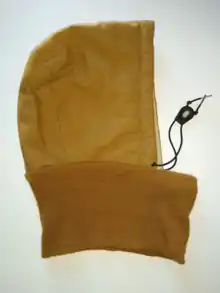Neck gaiter
A neck gaiter, or neck warmer, also known as a buff,[1] is an article of clothing worn about the neck for warmth. It is a closed tube of fabric, often thick fleece, merino wool, synthetic wicking, or knit material, which is slipped on and off over the head. It can also be pulled up over the mouth to keep out wind, sand and other debris. Some balaclavas have a thin hood attached to what is essentially a neck gaiter.


Informal medical uses
Following the onset of the coronavirus pandemic, some media and governmental entities have included neck gaiters among apparel items for non-medical personnel to use to shield against viruses, when conventional personal protective equipment is unavailable. Examples have included WebMD[2] and Riverside County, California health officials.[3]
In 2020, a method was developed which allowed researchers to visualize the effect of masks blocking droplet emission during speaking.[4] However, some media outlets claimed that neck gaiters were worse than not wearing masks at all in the COVID-19 pandemic, misinterpreting the study which was intended to demonstrate a method for evaluating masks (and not actually to determine the effectiveness of different types of masks).[5][6][7] The study also only looked at one wearer wearing the one neck gaiter made from a polyester/spandex blend, which is not sufficient evidence to support the claim about gaiters made in the media.[6] The study found that the neck gaiter, which was made from a thin and stretchy material, appeared to be ineffective at limiting airborne droplets expelled from the wearer; Isaac Henrion, one of the co-authors, suggests that the result was likely due to the material rather than the style, stating that "Any mask made from that fabric would probably have the same result, no matter the design."[8] Warren S. Warren, a co-author, said that they tried to be careful with their language in interviews, but added that the press coverage has "careened out of control" for a study testing a measuring technique.[5]
In a later study (2020, preprint) funded by the National Institute for Occupational Safety and Health, part of the US Centers for Disease Control and Prevention, researchers found that neck gaiters and other face masks can significantly reduce the expulsion of small respiratory aerosol particles during coughing, suggesting that various types of face coverings can make an important contribution to reducing the quantity of aerosol particles containing viruses—such as SARS-CoV-2 during the COVID-19 pandemic—released into the environment by infected people (source control).[9] The results showed that a single-layered gaiter blocked 47% and a double-layered gaiter blocked 60% of the test aerosols from being released into the environment, with increasing efficiency at larger aerosol sizes and vice versa.[9]
References
- Guinness, Harry (January 18, 2020). "A buff is indispensable, and you absolutely need one". Popular Science. Retrieved August 12, 2020.
- Hansa D. Bhargava, MD (April 16, 2020). "Coronavirus Face Masks: What You Should Know,". WebMD.
- Luke Money; Deborah Netburn; Rong-Gong Lin II (April 2, 2020). "Face masks could provide coronavirus protection. But there's a 'but'". Los Angeles Times. Archived from the original on April 2, 2020. Retrieved August 12, 2020.
- Fischer, Emma P.; et al. (August 7, 2020). "Low-cost measurement of facemask efficacy for filtering expelled droplets during speech". Science Advances. doi:10.1126/sciadv.abd3083. Retrieved August 12, 2020.
- Lambert, Jonathan (12 August 2020). "4 reasons you shouldn't trash your neck gaiter based on the new mask study". Science News.
- Saplakoglu, Yasemin. "Should you ditch your gaiter as a face mask? Not so fast, scientists say". Live Science.
- Parker-Pope, Tara (17 August 2020). "Save the Gaiters!". The New York Times.
- Krubsack, Rachel (14 August 2020). "Gaiters getting a bad rap for COVID-19 protection?". J. J. Keller.
- Lindsley, William G; Blachere, Francoise M.; Law, Brandon F.; Beezhold, Donald H.; Noti, John D. (7 October 2020). "Efficacy of face masks, neck gaiters and face shields for reducing the expulsion of simulated cough-generated aerosols". medRxiv. doi:10.1101/2020.10.05.20207241. Cite journal requires
|journal=(help) This article incorporates text from this source, which is in the public domain.
This article incorporates text from this source, which is in the public domain.
